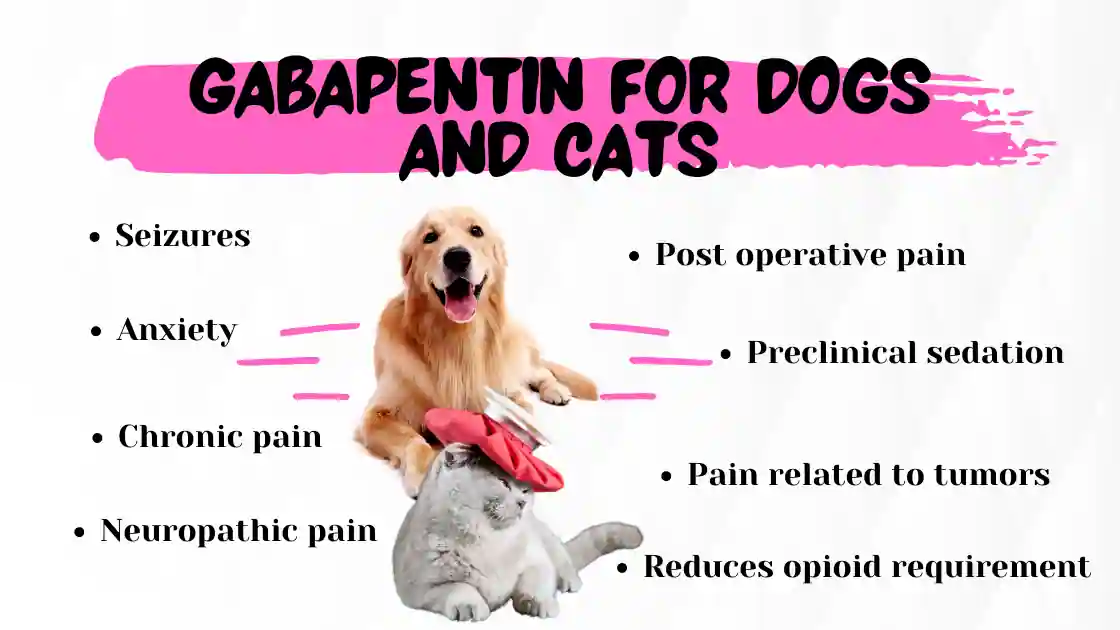Uses, Dosage, Side Effects and Common FAQs
Gabapentin for Dogs and Cats
Gabapentin is a structural analogue of gamma amino butyric acid (GABA) which decreases the release of excitatory neurotransmitters by increasing the levels of GABA in the CNS. It is used both in dogs and cats for management of seizures and pain in combination with other analgesic agents. It has been shown to be an appropriate treatment for reducing hyperalgesia and allodynia associated with neuropathic pain.
Exact mechanism of action is not well understood but it is absorbed from duodenum, metabolised in the liver and excreted through kidneys. It has a half-life of 3 to 4 hours.
In human medicine it is being used for treatment of seizures, different types of pain including neuropathic pain, diabetic neuropathy, malignant pain, complex regional pain, trigeminal neuralgia and central pain etc.
Uses, Dosage, Side effects, and Preparations of Gabapentin
Uses of Gabapentin in Dogs and Cats
For a quick reference it can be used in case of-
- Seizures (neonatal hypoxia – equine) /Epilepsy (refractory / idiopathic)
- Chronic pain (Osteoarthritis/ Degenerative joint disease)
- Neuropathic pain (intervertebral disc disease)
- Post operative pain
- To reduce opioid requirement for pain management
- Preclinical sedation
- For anxiety related to separation and travel stress
- Pain related to tumors or cancer (malignancy)
Usually, gabapentin is used for the treatment of seizures and chronic neuropathic pain along with other drugs (may have synergistic effect i.e. total effect will be more than sum of the both). It is a good choice for multi-modal analgesia. But it is also used as anxiolytic for transportation, examination and diagnostic procedures related stress specially in cats.
In horses, gabapentin is used for management / treatment of seizures resulted from hypoxic ischemic encephalopathy.
Dosage
Dogs: 10–20 mg/kg body weight orally 3 to 4 times in a day at equal intervals
Cats: 5–10 mg/kg body weight 2 to 3 times in a day at equal intervals.
In case of missed doses, give the next schedule dose but never give two doses at once or extra dose to compensate the missed dose.
Frequent administration helps in maintaining the plasma concentrations in dogs and cats as it is rapidly absorbed (reaches at peak in 2-3 hours) and rapidly eliminated through kidneys.
Gradual increment in the doses is recommended to achieve the desired effect and to avoid side effects like sedation and ataxia. Sedation is likely to happen in both dogs and cats at the dose rate of 20 mg/kg body weight or above.
- For Anxiolytic effect in cats or preclinical sedation– 20 mg/kg PO (50 to 100 mg/cat) approximately 2-3 hours before travel and use with precaution in cats suffering from kidney disease.
- In cats it has been used by transdermal route also but scarce literature is present and poor bioavailability is the issue.
Side effects and Precautions
Most common side effects seen are ataxia and dose dependent mild sedation. In some case side effects like hypersalivation, nausea, vomiting, diarrhoea, muscle fasciculation and anisocoria have also been reported.
Ataxia caused due to administration is transient and wears off in 6 to 8 hours. Sudden withdrawal from a prolonged therapy may result into nervous signs so tapering of doses is recommended before discontinuation. Pets can be completely weaned off from the therapy within two to three weeks with gradual tapering.
Simultaneous administration of aluminium and magnesium containing antacids may result into reduced GI absorption.
Gabapentin comes in capsule, tablet and syrup forms. Beware of human preparations containing xylitol which is toxic for pets.
As a sole drug it may not be a good choice for acute pain management so should be used in combination with steroids / NSAIDs / Opioids (hydromorphone / morphine – with caution) etc. according to the condition and patient status. It should be use with caution in patients with kidney ailments due to its excretion from kidney.
It may not be effective as a pain management drug in case of administration at less frequent interval than indicated and at less than recommended dosage.
Pets on Gabapentin may show false positive results for urinary protein tests.
Safety
Gabapentin has shown teratogenic effects and foetal losses in laboratory animals. It should be avoided during pregnancy or lactation and only be used when the benefits outweigh the potential risk because it is present in the milk too.
Sometimes it is prescribed for off label use in this case you must follow directions of your veterinarian and take precautions.
In case of an accidental overdose immediately contact your veterinarian or nearby veterinary emergency service centre.
Storage
Capsules, tablets or oral syrups can be stored at room temperature. Follow the directions printed on label.
Available commercial preparations or brand names
Tablets:Vetina Gabapentin, Neurontin, Gantin Forte, Gralise,
Capsules: Gabarone, Neurostil, Gabapin,
Syrup: Neurontin, Gabapen
Each formulation may not be suitable for dogs / cats.
Chill Protocol
(Cummings School of Veterinary Medicine at Tufts University)

It is used for the management of aggressive and fearful dogs (for safe handling, blood sample collections. Non-invasive diagnostic procedures) which includes combination of gabapentin, melatonin and acepromazine (oral transmucosal).
Melatonin has calming effect and acepromazine has behaviour modifying effects like tranquilisation and sedation. Both has synergistic effect with Gabapentin and produces calming effects.
- Gabapentin – 20 to 25 mg/kg PO 12 hours before the appointment
- Gabapentin – 20 to 25 mg/kg PO + Melatonin – small dogs, 0.5 to1 mg PO; medium dogs, 1 to 3 mg PO; large dogs, 5 mg PO one to two hours before the appointment
- Acepromazine – 0.025 to 0.05 mg/kg half an hour before the appointment
Sedation may last from a few hours to 24 hours. And dosage must be adjusted according to the health condition of pet.
FAQs
Can you give Trazadone and Gabapentin at the same time?
Yes, it is advisable to use both at the same time for management of anxiety like disorders. Doses can be adjusted between the two.
Cat is limping after giving gabapentin?
Ataxia or lameness after administration is common if it is given as anxiolytic or higher doses. Keep the cat inside the cage or carrier or confined for a period of 4 to 6 hours or until symptoms disappears because it is transient and pet become normal with the time.
After giving Gabapentin it has been a long time why my pet is still sleepy?
If sedation or side effects like incoordination / staggering persist more than 12 hours then your pet may have kidney or liver problems.
Can I give CBD oil along with gabapentin to my pet?
No, it is not recommended to give both in combination. It may increase the sedation.
After giving gabapentin dog can't walk?
It is common and it will automatically become normal after a few hours (6-8 hours).
Can gabapentin kill a dog?
Yes. It can be fatal if consumed in large amount due to accidental overdosing.
How much (dosage / dose of) gabapentin can I give my dog for pain?
Recommended dose is variable according to the use which varies from 10-20 mg per kg body weight two to three times in day.
Side effects of stopping gabapentin in dogs?
Abrupt discontinuation may result into side effects like onset of seizures or nervous signs.
Double dose of gabapentin in dogs?
Do not overdose if you miss a dose. Give next dose on scheduled time.
Gabapentin dog side effects urination?
Less control of urination may be seen due to sedation and over relaxation of the urinary sphincter.
Is gabapentin for dogs and cats the same?
Yes. Same preparation can be used for dogs and cats but may need to adjust according to the body weight.
Can I give gabapentin to my cat or dog?
Yes. If your veterinarian has prescribed then you can use gabapentin but with first dosing you can see some side effects.
Can you give human gabapentin to a dog?
Yes / No. Human preparations can be given to the dogs off label but preparations containing Xylitol are toxic for the dogs.
What is alternative to gabapentin in dogs?
Pregabalin is also available in the market which can be used as an alternative if prescribed by veterinarian for off label use. Or other combination of pain killers or sedatives can be tried.
References
- Steagall PV, Monteiro-Steagall BP. Multimodal analgesia for perioperative pain in three cats. J Feline Med Surg. 2013;15(8):737-743.
- Vettorato E, Corletto F. Gabapentin as part of multi-modal analgesia in two cats suffering multiple injuries. Vet Anaesth Analg. 2011;38(5):518-520.
- Miller A, Price G. Gabapentin toxicity in renal failure: the importance of dose adjustment. Pain Med. 2009;10(1):190-192.
- Zand L, McKian KP, Qian Q. Gabapentin toxicity in patients with chronic kidney disease: a preventable cause of morbidity. Am J Med. 2010;123(4):367-373.
- Slovak JE, Costa AP. A pilot study of transdermal gabapentin in cats. J Vet Intern Med. 2021;35(4):1981-1987.
- Monteiro ER, Junior AR, Assis HM, Campagnol D, Quitzan JG. Comparative study on the sedative effects of morphine, methadone, butorphanol or tramadol, in combination with acepromazine, in dogs. Vet Anaesth Analg. 2009;36(1):25-33.
- https://www.wedgewoodpharmacy.com/medications/gabapentin/#:~:text=Gabapentin%20is%20used%20in%20both,NSAIDs%2C%20allowing%20prescribing%20lower%20doses.
- https://www.cliniciansbrief.com/article/chill-protocol-manage-aggressive-fearful-dogs
Information given in this article is for veterinary professionals only. Utmost care has been taken and references have been reviewed before publishing.





